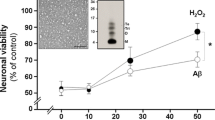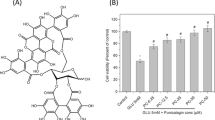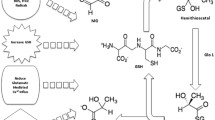Abstract
Quercetin is a common flavonoid polyphenol which has been shown to exert neuroprotective actions in vitro and in vivo. Though quercetin has antioxidant properties, it has been suggested that neuroprotection may be ascribed to its ability of inducing the cell’s own defense mechanisms. The present study investigated whether quercetin could increase the levels of paraoxonase 2 (PON2), a mitochondrial enzyme expressed in brain cells, which has been shown to have potent antioxidant properties. PON2 protein, mRNA, and lactonase activity were highest in mouse striatal astrocytes. Quercetin increased PON2 levels, possibly by activating the JNK/AP-1 pathway. The increased PON2 levels induced by quercetin resulted in decreased oxidative stress and ensuing toxicity induced by two oxidants. The neuroprotective effect of quercetin was significantly diminished in cells from PON2 knockout mice. These findings suggest that induction of PON2 by quercetin represents an important mechanism by which this polyphenol may exert its neuroprotective action.




Similar content being viewed by others
References
Arts ICW, Hollman PCH (2005) Polyphenols and disease risk in epidemiological studies. Am J Clin Nutr 81(Suppl.):317S–325S
Kelsey NA, Wilkins HM, Linseman DA (2010) Nutraceutical antioxidants as novel neuroprotective agents. Molecules 15:7792–7814
Scalbert A, Andres-Lacueva C, Arita M, Kroon P, Manach C, Urpi-Sarda M, Wishart D (2011) Databases on food phytochemicals and their health-promoting effects. J Agric Food Chem 59:4331–4348
Halliwell B (2006) Oxidative stress and neurodegeneration: where are we now? J Neurochem 97:1634–1658
Lin MT, Beal MF (2006) Mitochondrial dysfunction and oxidative stress in neurodegenerative diseases. Nature 443:787–795
Martin I, Grotewiel MS (2006) Oxidative damage and age-related functional declines. Mech Aging Dev 127:411–423
USDA (United States Department of Agriculture) (2003) USDA database for the flavonoid content of selected foods. USDA, Beltsville Human Nutrition Research Center, Beltsville, MD
Chen C, Zhou J, Ji C (2010) Quercetin: a potential drug to reverse multidrug resistance. Life Sci 87:333–338
Harwood M, Danielewska-Nikiel B, Borzelleca JF, Flamm GW, Williams GM, Lines TC (2007) A critical review of the data related to the safety of quercetin and lack of evidence of in vivo toxicity, including lack of genotoxic/carcinogenic properties. Food Chem Toxicol 45:2179–2205
Ossola B, Kaariainen TM, Mannisto PT (2009) The multiple faces of quercetin in neuroprotection. Expert Opin Drug Saf 8:397–409
Mercer LD, Kelly BL, Horne MK, Beart PM (2005) Dietary polyphenols protect dopamine neurons from oxidative insults and apoptosis; investigations in primary rat mesencephalic cultures. Biochem Pharmacol 69:339–345
Bournival J, Quessy P, Martinoli MG (2009) Protective effects of resveratrol and quercetin against MPP+-induced oxidative stress act by modulating markers of apoptotic death in dopaminergic neurons. Cell Mol Neurobiol 29:1169–1180
Bournival J, Plouffe M, Renaud J, Provencher C, Martinoli MG (2012) Quercetin and sesamin protect dopaminergic cells from MPP+-induced neuroinflammation in a microglial (N9)-neuronal (PC12) coculture system. Oxidat Med Cell Longev, ID 921941, pp. 11. doi:10.1155/2012/921941
Arredondo F, Echeverry C, Abin-Carriquiry JA, Blasina F, Antunez K, Jones DP, Go YM, Liang YL, Dajas F (2010) After cellular internalization, quercetin causes Nrf2 nuclear translocation, increases glutathione levels, and prevents neuronal death against an oxidative insult. Free Rad Biol Med 49:738–747
Zhang ZJ, Cheang LCV, Wang MW, Lee SMY (2011) Quercetin exerts a neuroprotective effect through inhibition of the iNOS/NO system and pro-inflammatory gene expression in PC-12 cells and in zebrafish. Int J Mol Med 27:195–203
Hu P, Wang M, Chen WH, Liu J, Chen L, Yin ST, Yong W, Chen JT, Wang HL, Ruan DY (2008) Quercetin relieves chronic lead exposure-induced impairment of synaptic plasticity in rat dentate gyrus in vivo. Naunyn-Schmiedeberg’s Arch Pharmacol 378:43–51
Barcelos GRM, Grotto D, Serpeloni JM, Angeli JPF, Rocha BA, Souza VVO, Vicentini JT, Emanuelli T, Bastos JK, Antunes LMG, Knasmuller S, Barbosa F Jr (2011) Protective properties of quercetin against DNA damage and oxidative stress induced by methylmercury in rats. Arch Toxicol 85:1151–1157
Selvakumar K, Bavithra S, Suganthi M, Benson CS, Elumalai P, Arunkumar R, Krishnamoorthy G, Venkataraman P, Arunakaran J (2012) Protective role of quercetin on PCBs-induced oxidative stress and apoptosis in hippocampus of adult rats. Neurochem Res 37:708–721
Lv C, Hong T, yang Z, Zhang Y, Wang L, Dong M, Zhao J, Mu J, Meng Y (2012) Effect of quercetin in the 1-methyl-4-phenyl-1,2,3,6-tetrahydropyridine-induced mouse model of Parkinson’s disease. Evid Based Complem Altern Med, ID 928643, pp. 6. doi:10.1155/2012/928643
Yao RQ, Qi DS, Yu HL, Liu J, Yang LH, Wu XX (2012) Quercetin attenuates cell apoptosis in focal cerebral ischemia rat brain via activation of BDNF-TrkB-PI3 K/Akt signaling pathway. Neurochem Res 37:2777–2786
Keddy PGW, Dunlop K, Warford J, Samson ML, Jones QRD, Vasantha Rupasinghe HP, Roberstson GS (2012) Neuroprotective and anti-inflammatory effects of the flavonoid-enriched fraction AF4 in a mouse model of hypoxic-ischemic brain injury. PLoS ONE 7(12):e52324. doi:10.1371/journal.pone.0051324
Karuppagounder SS, Madathil SK, Pandey M, Haobam R, Rajamma U, Mohanakumar KP (2013) Quercetin up-regulates mitochondrial complex-I activity to protect against programmed cell death in rotenone model of Parkinson’s disease in rats. Neuroscience 236:136–148
Boots AW, Haenen GRMM, Bast A (2008) Health effects of quercetin: from antioxidant to nutraceutical. Eur J Pharmacol 585:325–337
Schaffer S, Halliwell B (2012) Do polyphenols enter the brain and does it matter? Some theoretical and practical considerations. Genes Nutr 7:99–109
Halliwell B, Rafter J, Jenner A (2005) Health promotion by flavonoids, tocopherols, tocotrienols, and other phenols: direct or indirect effects? Antioxidant or not? Am J Clin Nutr 81(Suppl.):268S–276S
Pandey KB, Rizvi SI (2009) Plant polyphenols as dietary antioxidants in human health and disease. Oxid Med Cell Longev 2:270–278
Fraga CG, Galleano M, Verstraeten SV, Oteiza PI (2010) Basic biochemical mechanisms behind the health benefits of polyphenols. Mol Aspec Med 31:435–445
Kay CD (2010) The future of flavonoid research. Br J Nutr 104:S91–S95
Kang JH, Chang SY, Jang HJ, Cho JM, Kim DB, Lee SS, Ko SH, Park YM, Needs PW, Jo YH, Kim MJ (2009) Quercetin-induced upregulation of human GCLC gene is mediated by cis-regulatory element for early growth response protein-1 (EGR1) in INS-1 beta-cells. J Cell Biochem 108:1346–1355
Hayashi Y, Matsushima M, Nakamura T, Shibasaki M, Hashimoto N, Imaizumi K, Shimokata K, Hasegawa Y, Kawabe T (2012) Quercetin protects against pulmonary oxidant stress via heme oxygenase-1 induction in lung epithelial cells. Biochem Biophys Res Commun 417:169–174
Granado-Serrano AB, Martin MA, Bravo L, Goya L, Ramos S (2012) Quercetin modulates Nrf2 and glutathione-related defenses in HepG2 cells: involvement of p38. Chem Biol Interact 195:154–164
Ng CJ, Wadleigh DJ, Gangopadhyyay A, Hama S, Grijalva VR, Navab M, Fogelman AM, Reddy ST (2001) Paraoxonase-2 is a ubiquitously expressed protein with antioxidant properties and is capable of preventing cell-mediated oxidative modification of low density lipoprotein. J Biol Chem 276:44444–44449
Horke S, Witte I, Wilgenbus P, Kruger M, Starnd D, Forstermann U (2007) Paraoxonase-2 reduces oxidative stress in vascular cells and decreases endoplasmic reticulum stress-induced caspase activation. Circulation 115:2055–2064
Horke S, Witte I, Altenhoffer S, Wilgenbus P, Goldeck M, Forstermann U, Xiao J, Kramer GL, Haines DC, Chowdhary PK, Haley RW, Teiber JF (2010) Paraoxonase-2 is down regulated by the Pesudomonas aeruginosa quorum-sensing signal N-(3-oxododecanyl)-L-homoserine lactone and attenuates oxidative stress induced by pyocyanin. Biochem J 426:73–83
Levy E, Trudel K, Bendayan M, Seidman E, Delvin E, Elchebly M, Lavoie JC, Precourt LP, Amre D, Sinnett D (2007) Biological role, protein expression, subcellular localization, and oxidative stress response of paraoxonase 2 in the intestine of human and rats. Am J Physiol Gastrointest Liver Physiol 293:G1252–G1261
Giordano G, Cole TB, Furlong CE, Costa LG (2011) Paraoxonase 2 (PON2) in the mouse central nervous system: a neuroprotective role? Toxicol Appl Pharmacol 256:369–378
Primo-Parmo SL, Sorenson RC, Teiber J, La Du BN (1996) The human serum paraoxonase/arylesterase gene (PON1) is one member of a multigene family. Genomics 33:498–507
Draganov DI, La Du BN (2004) Pharmacogenetics of paraoxonase: a brief review. Naunyn Schmiedebergs Arch Pharmacol 369:78–88
Giordano G, Tait L, Furlong CE, Cole TB, Kavanagh TJ, Costa LG (2013) Gender differences in brain susceptibility to oxidative stress are mediated by levels of paraoxonase-2 expression. Free Rad Biol Med 58:98–108
Higgins GC, Beart PM, Shin YS, Chen MJ, Cheung NS, Nagley P (2010) Oxidative stress: emerging mitochondrial and cellular themes and variations in neuronal injury. J Alzheim Dis 20(Suppl. 2):S453–S473
Devarajan A, Bourquard N, Hama S, Navab M, Grijalva VR, Morvardi S, Clarke C, Vergnes L, Reue K, Teiber JF, Reddy ST (2011) Paraoxonase 2 deficiency alters mitochondrial function and exacerbates the development of atherosclerosis. Antiox Redox Signal 14:341–351
Costa LG, Giordano G, Furlong CE (2011) Pharmacological and dietary modulators of paraoxonase 1 (PON1) activity and expression: the hunt goes on. Biochem Pharmacol 81:337–344
Rosenblat M, Draganov D, Watson CE, Bisgaier CL, La Du BN, Aviram M (2003) Mouse macrophage paraoxonase-2 activity is increased whereas cellular paraoxonase 3 activity is decreased under oxidative stress. Arterioscler Thromb Vasc Biol 23:468–474
Fuhrman B, Khateeb J, Shiner M, Nitzan O, Karry R, Volkova N, Aviram M (2008) Urokinase plasminogen activator upregulates paraoxonase 2 expression in macrophages via an NADPH oxidase-dependent mechanism. Arterioscler Thromb Vasc Res 28:1361–1367
Fuhrman B, Gantman A, Khateeb J, Volkova N, Horke S, Kiyan J, Dumler I, Aviram M (2009) Urokinase activates macrophage PON2 gene transcription via the PI3 K/ROS/MEK/SREBP-2 signalling cascade mediated by the PDGFR-beta. Cardiovasc Res 84:145–154
Rosenblat M, Volkova N, Roqueta-Rovera M, Nakamura MT, Aviram M (2010) Increased macrophage cholesterol biosysnthesis and decreased cellular paraoxonase 2 (PON2) expression in Δ6-desaturase knockout (6-DS-KO) mice: beneficial effects of arachidonic acid. Atherosclerosis 210:414–421
Shiner M, Fuhrman B, Aviram M (2007) Macrophage paraoxonase 2 (PON2) expression is upregulated by unesterified cholesterol through activation of the phosphatidylinositol 3-kinase (PI3 K) pathway. Biol Chem 388:1353–1358
Yehuda I, Madar Z, Szuchman-Sapir A, Tamir S (2011) Glabridin, a phytoestrogen from licorice root, up-regulates manganese superoxide dismutase, catalase and paraoxonase 2 under glucose stress. Phytother Res 25:659–667
Rosenblat M, Hayek T, Hussein K, Aviram M (2004) Decreased macrophage paraoxonase 2 expression in patients with hypercholesterolemia is the result of their increased cellular cholesterol content: effect of atorvastatin therapy. Arterioscler Thromb Vasc Biol 24:175–180
Shiner M, Fuhrman B, Aviram M (2007) Macrophage paraoxonase 2 (PON2) expression is up-regulated by pomegranate juice phenolic anti-oxidants via PPARγ and AP-1 pathway activation. Atherosclerosis 195:313–321
Stucker Fernandez E, de Oliveira Machado M, Minuzzi Becker A, de Andrade F, Maraschin M, Luiz da Silva E (2012) Yerba mate (Ilex paraguariensis) enhances the gene modulation and activity of paraoxonase-2: in vitro and in vivo studies. Nutrition 28:1157–1164
Boesch-Saadatmandi C, Pospissil RT, Graeser AC, Canali R, Boomgaarden I, Doering F, Wolffram S, Egert S, Mueller MJ, Rimbach G (2009) Effect of quercetin on paraoxonase 2 levels in RAW264.7 macrophages and in human monocytes—role of quercetin metabolism. Int J Mol Sci 10:4168–4177
Draganov DI, Teiber JF, Speelman A, Osawa Y, Sunahara R, La Du BN (2005) Human paraoxonases (PON1, PON2 and PON3) are lactonases with overlapping and distinct substrate specificities. J Lipid Res 46:1239–1247
Ott M, Gogvadze V, Orrenius S, Zhivotovsky B (2007) Mitochondria, oxidative stress and cell death. Apoptosis 12:913–922
Altenhofer S, Witte I, Teiber JF, Wilgenbus P, Pautz A, Li H, Daiber A, Witan H, Clement AM, Forstermann U, Horke S (2010) One enzyme, two functions. PON2 prevents mitochondrial superoxide formation and apoptosis independent from its lactonase activity. J Biol Chem 285:24398–24403
Fiorani M, Guidarelli A, Blasa M, Azzolini C, Candiracci M, Piatti E, Cantoni O (2010) Mitochondria accumulate large amounts of quercetin: prevention of mitochondrial damage and release upon oxidation of the extramitochondrial fraction of the flavonoid. J Nutr Biochem 21:397–404
Notas G, Nifli AP, Kampa M, Pelekanou V, Alexaki VI, Theodoropoulos P, Vercauteren J, Castanas E (2012) Quercetin accumulates in nuclear structures and triggers specific gene expression in epithelial cells. J Nutr Biochem 23:656–666
Jones QRD, Warford J, Vasantha Rupasinghe HP, Robertson GS (2012) Target-based selection of flavonoids for neurodegenerative disorders. Trends Pharmacol Sci 33:602–610
Mehan S, Meena H, Sharma D, Sankhla R (2011) JNK: a stress-activated protein kinase therapeutic strategies and involvement in Alzheimer’s and various neurodegenerative abnormalities. J Mol Neurosci 43:376–390
Weston CR, Davis RJ (2007) The JNK signal transduction pathway. Curr Opin Cell Biol 19:142–149
Holst B, Williamson G (2008) Nutrients and phytochemicals: from bioavailability to bioefficacy beyond antioxidants. Curr Opin Biotechnol 19:73–82
Halliwell B (2008) Are polyphenols antioxidants or pro-oxidants? What do we learn from cell culture and in vivo studies? Arch Biochem Biophys 476:107–112
Chang YF, Hsu YC, Hung HF, Lee HJ, Lui WY, Chi CW, Wang JJ (2009) Quercetin induces oxidative stress and potentiates the apoptotic action of 2-methoxyestradiol in human hepatoma cells. Nutr Cancer 61:735–745
Granado-Serrano AB, Martin MA, Bravo L, Goya L, Ramos S (2010) Quercetin modulates Nf-kB and AP-1/JNK pathways to induce cell death in human hepatoma cells. Nutr Cancer 62:390–401
Miodini P, Fioravanti L, Di Fronzo G, Cappelletti V (1999) The two phyto-estrogens genistein and quercetin exert different effects on oestrogen receptor function. Br J Cancer 80:1150–1155
van der Woude H, ter Veld MGR, Jacobs N, van der Saag PT, Murk AJ, Rietjens IMCM (2005) The stimulation of cell proliferation by quercetin is mediated by the estrogen receptor. Mol Nutr Food Res 49:763–771
Galluzzo P, Martini C, Bulzomi P, Leone S, Bolli A, Pallottini V, Marino M (2009) Quercetin-induced apoptotic cascade in cancer cells: antioxidant versus estrogen receptor alpha-dependent mechanisms. Mol Nutr Food Res 53:699–708
Bulzomi P, Galluzzo P, Bolli A, Leone S, Acconcia F, Marino M (2011) The pro-apoptotic effect of quercetin in cancer cell lines requires ERβ-dependent signals. J Cell Physiol 227:1891–1898
Hollman PC, deVries JH, van Leeuwen SD, Mengelers MJ, Katan MB (1995) Absorption of dietary quercetin glycosides and quercetin in healthy ileostomy volunteers. Am J Clin Nutr 62:1276–1282
Conquer JA, Maiani G, Azzini E, Raguzzini A, Holub BJ (1998) Supplementation with quercetin markedly increases plasma quercetin concentration without effect on selected risk factors for heart disease in healthy subjects. J Nutr 128:593–597
Manach C, Williamson G, Morand C, Scalbert A, Remesy C (2005) Bioavailability and bioefficacy of polyphenols in humans. I. Review of 97 bioavailability studies. Am J Clin Nutr 81(Suppl.):230S–242S
Youdim KA, Qaiser MZ, Begley DJ, Rice-Evans CA, Abbott NJ (2004) Flavonoid permeability across an in situ model of the blood-brain barrier. Free Rad Biol Med 36:592–604
Faria A, Pestana D, Teixera D, Azevedo J, De Freitas V, Mateus N, Calhau C (2010) Flavonoid transport across RBE4 cells: a blood-brain barrier model. Cell Mol Biol Lett 15:234–241
Ishisaka A, Ichikawa S, Sakakibara H, Piskula MK, Nakamura T, Kato Y, Ito M, Miyamoto K, Tsuji A, Kawai Y, Terao J (2011) Accumulation of orally administered quercetin in brain tissue and its antioxidative effects in rats. Free Rad Biol Med 51:329–336
deBoer VCJ, Dihal AA, van der Woude H, Arts ICW, Wolffram A, Alink GM, Rietjens IMCM, Keijer J, Hollma PCH (2005) Tissue distribution of quercetin in rats and pigs. J Nutr 135:1718–1725
Bieger J, Cermak R, Blank R, deBoer VCJ, Hollman PCH, Kamphues J, Wolffram S (2008) Tissue distribution of quercetin in pigs after long-term dietary supplementation. J Nutr 138:1417–1420
Huebbe P, Wagner AE, Boesch-Saadatmandi C, Sellmer F, Wolffram S, Rimbach G (2010) Effect of dietary quercetin on brain quercetin levels and the expression of antioxidant and Alzheimer’s disease relevant genes in mice. Pharmacol Res 61:242–246
Russo M, Spagnuolo C, Tedesco I, Bilotto S, Russo GM (2012) The flavonoid quercetin in disease prevention and therapy: facts and fancies. Biochem Pharmacol 83:6–15
Dajas F, Rivera-Megret F, Blasina F, Arredondo F, Abin-Carriquiry JA, Costa G, Echeverry C, Lafon L, Heizen H, Ferreira M, Morquio A (2003) Neuroprotection by flavonoids. Braz J Med Biol Res 36:1613–1620
Das S, Mandal AK, Ghosh A, Panda S, Das N, Sarkar S (2008) Nanoparticulated quercetin in combating age related cerebral oxidative injury. Curr Aging Sci 1:169–174
Dhavan S, Kapil R, Singh B (2011) Formulation development and systematic optimization of solid lipid nanoparticles of quercetin for improved brain delivery. J Pharm Pharmacol 63:342–351
Day AJ, Mellon F, Barron D, Sarrazin G, Morgan MRA, Williamson G (2001) Human metabolism of dietary flavonoids: identification of plasma metabolites of quercetin. Free Rad. Res. 35:941–952
Fiorani M, Accorsi A, Cantoni O (2003) Human red blood cells as a natural flavonoid reservoir. Free Rad Res 37:1331–1338
Verzelloni E, Pellacani C, Tagliazucchi D, Tagliaferri S, Calani L, Costa LG, Brighenti F, Borges G, Crozier A, Conte A, Del Rio D (2011) Antiglycative and neuroprotective activity of colon-derived polyphenol catabolites. Mol Nutr Food Res 55:1–9
Acknowledgments
This study was supported in part by Grants P42ES04696 and P30ES07033 from the National Institute of Environmental Health Sciences, and P30HD02274 from the National Institute of Child Health and Human Development. We thank Dr. Fred Farin and Jasmine Wilkerson from the Functional Genomics and Proteomics Facility in the Dept. of Environmental and Occupational Health Sciences at the University of Washington for measuring PON2 mRNA levels.
Author information
Authors and Affiliations
Corresponding author
Rights and permissions
About this article
Cite this article
Costa, L.G., Tait, L., de Laat, R. et al. Modulation of Paraoxonase 2 (PON2) in Mouse Brain by the Polyphenol Quercetin: A Mechanism of Neuroprotection?. Neurochem Res 38, 1809–1818 (2013). https://doi.org/10.1007/s11064-013-1085-1
Received:
Revised:
Accepted:
Published:
Issue Date:
DOI: https://doi.org/10.1007/s11064-013-1085-1




